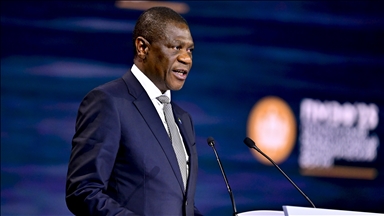'We will do whatever it takes to achieve year-end inflation target,' Turkish central bank chief tells Anadolu
'We will ensure that demand conditions do not impair the disinflation process'

- 'Our priority will be to determine the policy rate in a way to ensure the tightness required by the projected disinflation path'
NEW YORK
Türkiye’s Central Bank chief on Thursday vowed to take all necessary steps to meet a year-end inflation target of 24%.
"We will do whatever it takes to achieve our year-end inflation target of 24%," Governor Fatih Karahan told Anadolu in an exclusive interview, saying that the bank will not allow demand conditions to impair the disinflation path.
As part of his engagements in the US, Karahan addressed current economic issues during his visit to Anadolu’s New York office. He emphasized that the decline in inflation is primarily driven by a decrease in the underlying trend, supported by tight monetary policy, rather than base effects.
Karahan highlighted that this improvement in the underlying trend will continue to be a key factor throughout the rest of the year, reaffirming the central bank’s commitment to its inflation target.
Stressing the importance of maintaining a tight monetary policy stance, Karahan underscored the necessity of keeping demand at disinflationary levels to ensure further progress in reducing inflation.
“We will ensure that demand conditions do not impair the disinflation process,” he said, noting that the conversion to Turkish lira deposits has outpaced conversions to foreign currency deposits.
Looking ahead, Karahan stated that the central bank’s priority will be setting the policy rate at a level that ensures the tightness required by the projected disinflation path. He reiterated the bank’s unwavering stance on monetary policy.
Karahan also addressed a range of economic topics in the interview with Anadolu, including the fight against inflation, monetary and interest rate policy, FX-protected deposits, the conversion to Turkish lira, and foreign currency loans.
Anadolu: The inflation figure came out high in January, but we saw a decline again in February. Going forward, how should we read the inflation data?
Fatih Karahan: Annual inflation has been on a decline since its peak in May 2024. A significant portion of the decline in the early months of the disinflation process was due to the base effect stemming from developments in the summer of 2023. During this period, we put the emphasis onto monthly price developments to better guide expectations for the policy rate. Accordingly, we were tracking the trend of seasonally adjusted underlying inflation indicators over the previous few months. Currently, we evaluate that the fall in inflation is driven by the decline in the underlying trend with the support of tight monetary policy, rather than by base effects. The improvement in the underlying trend will remain influential throughout the rest of the year. Besides, in some cases, seasonal adjustment methods fail to capture the changes in seasonality patterns that emerged after the pandemic. All in all, we believe that it would be more accurate to compare underlying trend indicators with those observed in the same month of the previous year.
With this in mind, when examining the underlying trend indicators for February, we see that the seasonally adjusted B index fell in 2025 to 2.8%, down from 4.3% in 2024, while the C index dropped to 2.4%, from 3.7% in 2024. These two indices typically tend to rise in January, February and July due to temporary factors beyond the control of the monetary policy. Distribution-based indicators such as the median and SATRIM can give a better idea for the course of inflation for these months. Median price increases fell from a monthly average of 4.7% in January-February of last year to 2.1% in the same period this year. We observed a similar decline in SATRIM. Overall, we see that the monthly underlying trend has dropped by a third for the B and C indicators, and by half for the median and SATRIM, compared to last year.
To better understand inflation dynamics, it is also useful to look at inflation by sub-items. In terms of annual inflation, we observe that goods inflation remains low, while services inflation, despite some rigidities beginning to dissipate, remains high. Here, rent and education items, which have time-dependent pricing and backward indexation, stand out. While annual rent inflation was 121% in February of last year, it decreased to 97% this year. So, in the case of rents, the level of inflation is high, and the pace of disinflation is slow. Likewise, we observe limited improvement in education prices.
Meanwhile, within the services group, we see a significant improvement in items that are more sensitive to monetary policy. For example, inflation in the restaurants and hotels item fell from 95% to 46%. This indicates that monetary tightening has been effective in reducing inflation in this kind of services.
We will do whatever it takes to achieve our year-end inflation target of 24%. We will maintain our tight monetary policy stance and continue to bring inflation down in line with our year-end targets.
Anadolu: Demand was strong in the fourth quarter. What does this data mean tell for the inflation outlook?
Fatih Karahan: To be able to understand demand conditions before the release of national income data for the fourth quarter, we were monitoring data such as card spending, credit growth and retail sales. In the fourth quarter, these data pointed to a disinflationary demand level, despite some resilience. The corresponding growth data released in February showed that demand was stronger than we had forecasted. Accordingly, we emphasized this in the latest MPC decision press release.
It is crucial for demand to remain at disinflationary levels for inflation to continue declining. In this respect, the data available for the first quarter so far show that retail sales remained strong in January, while vehicle trade and wholesale trade volume decelerated. Credit growth has been more modest compared to the final quarter. Meanwhile, data on credit card spending point to a weaker course in January and February.
Therefore, the available demand indicators for the first quarter, albeit with some uncertainty, imply that consumer spending has posted a milder course following the rise in the previous quarter. We will continue to evaluate this outlook as more demand indicators for the first quarter become available. We will ensure that demand conditions do not impair the disinflation process.
Anadolu: The current account deficit increased in January. In your monetary policy releases, you continue to emphasize the real appreciation of the Turkish lira. Can you share your insights on the real appreciation of the Turkish lira and the current account deficit outlook for 2025?
Fatih Karahan: Developments in the current account balance have indicated that current account deficit-to-GDP ratio decreased to 0.8 percent at the end of 2024, down from the pre-tightening level of 5 percent. The average ratio of current account deficit-to-GDP in the last two decades has been 3.7 percent, so 0.8 percent is significantly low compared to historical averages. Recent data suggest a slight increase in the current account deficit in 2025, though.
A look into the factors that may impact the current account balance in 2025 reveals that export-led downside risks stand out due to the uncertainty surrounding global trade. We have also observed a recent high course in the imports of consumer goods. We expect the current account deficit-to-GDP ratio in 2025 to be higher than in 2024, yet remain significantly below long-term averages.
As for real appreciation, our current monetary policy is not designed with a focus on the real appreciation of the Turkish lira. We do not have any targets for exchange rate levels and changes. However, our decisive monetary policy stance has led to an increased interest in the Turkish lira. As a natural consequence of this interest, we are experiencing both an increase in our reserves and a real appreciation.
We can evaluate the near-term outlook by examining the preferences of residents. Recently, Turkish lira deposit rates have decreased and withholding tax rates on Turkish lira deposits and money market funds have increased. In the meanwhile, we have taken steps to accelerate the phase out of FX-protected deposit accounts. In December, we introduced changes to reduce returns on FX-protected deposit accounts. In January, we terminated the long-term accounts and finally, in February, we discontinued the opening and renewal of FX-protected accounts for legal entities. Despite these developments, we observe an ongoing interest in the Turkish lira. Focusing on personal FX-protected accounts, the FX conversion rate was at around 10 percent in January, with the conversion rate to Turkish lira deposits hovering around 25 percent. In February, we observed only a limited change in both rates. The FX conversion rate and the Turkish lira deposit conversion rate were 12 percent and 23 percent, respectively. These developments indicate that among maturing FX-protected accounts, conversion to Turkish lira deposits has been higher than conversion to FX deposits.
I would like to reiterate that, in the upcoming period, our priority will be to determine the policy rate in a way to ensure the tightness required by the projected disinflation path. We will maintain our tight monetary policy stance until price stability is achieved via a sustained decline in inflation. Our decisive monetary policy stance will support the interest in the Turkish lira.
Anadolu: In January, you lowered the growth limit for foreign currency loans to 1.0 percent. At the beginning of March, with a new regulation, this limit was lowered to 0.5 percent and the scope of exemption was narrowed. What was the reason for this decision? Has the new regulation helped to achieve the desired slowdown in foreign currency lending?
Fatih Karahan: Tight monetary policy has been tightening the Turkish lira loan market as intended. However, FX loans are becoming relatively less costly due to the stable course of exchange rate. Indeed, the real sector has secured approximately USD 50 billion in financing through this channel since the end of 2023. This strong credit growth poses risks related to monetary expansion and the FX position of the corporate sector. In addition, FX credit growth increases demand for FX liquidity in the financial system. Recently, we have observed that this has led to an increase in FX deposit rates and heightened the risk of deposit dollarization. In January, we had already slightly tightened the FX loan growth limit. However, we observed that FX loan growth continued in the first quarter, stemming mostly from items exempt from the growth limit. In line with these observations, we have tightened both the scope of exemptions and the growth limits on FX loans.
Given the limited data available following the regulation, it is too early to draw conclusions. However, we assess that these changes will strengthen the monetary transmission mechanism and mitigate risks to macro-financial stability.
Anadolu Agency website contains only a portion of the news stories offered to subscribers in the AA News Broadcasting System (HAS), and in summarized form. Please contact us for subscription options.







